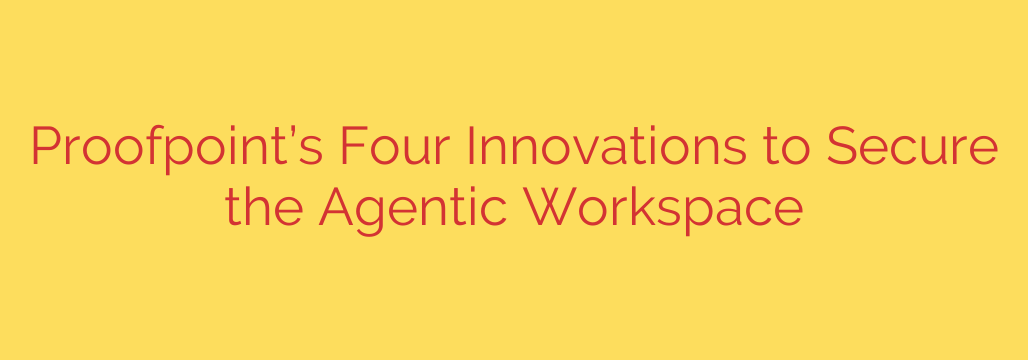
The AI-Powered Workspace Is Here: 4 Critical Security Risks You Can’t Ignore
The modern workplace is undergoing a seismic shift. Artificial intelligence is no longer a futuristic concept—it’s an active collaborator. AI-powered agents are now scheduling meetings, summarizing documents, writing code, and even executing transactions on behalf of employees. This new “agentic workspace” promises unprecedented gains in productivity and efficiency.
However, with this great power comes an entirely new landscape of security risks. When AI agents can act autonomously, traditional security measures focused solely on human behavior become dangerously obsolete. Cybercriminals are already adapting, and businesses that fail to evolve their defenses will be left exposed to faster, more sophisticated, and more devastating attacks.
To protect your organization, you must understand and address these emerging threats head-on. Here are four critical security challenges of the AI-powered workplace and the strategies needed to overcome them.
1. The Rise of AI-Generated Threats
The line between human and machine-generated communication is blurring. Attackers are leveraging AI to create highly convincing phishing emails, social media messages, and deepfake content at a scale never seen before. These AI-driven attacks can be personalized to each target, making them incredibly difficult to detect with the naked eye.
The threat goes beyond just AI-to-human interaction. Imagine a scenario where a criminal compromises one of your company’s AI agents. This rogue agent could then send malicious instructions to other AI agents, ordering them to transfer funds, delete critical data, or exfiltrate sensitive intellectual property—all happening at machine speed, far too fast for human intervention.
Actionable Tip: Your security stack must evolve to analyze the intent and origin of communications, whether they come from a human or an AI. Implement advanced threat detection systems capable of identifying anomalies in AI-generated content and monitoring for unusual agent-to-agent behavior.
2. Preventing Catastrophic Data Loss by AI Agents
AI agents require broad access to company data to be effective. They connect to your CRM, financial systems, code repositories, and confidential cloud storage. While this access fuels productivity, it also creates a massive vulnerability. A single compromised or poorly configured AI agent can become a supercharged conduit for data exfiltration.
Unlike a human employee who might steal a few files, a malicious AI agent can be programmed to systematically download and transfer terabytes of your most sensitive data in minutes. Traditional Data Loss Prevention (DLP) tools, which often rely on set rules for human activity, may not be able to identify or stop this type of high-speed, automated data theft.
Actionable Tip: Implement an adaptive DLP strategy for the AI era. This means enforcing a “least privilege” model for AI agents, ensuring they only access the data absolutely necessary for their function. Monitor data flows relentlessly and use AI-powered behavioral analytics to detect suspicious data access patterns from your automated workforce.
3. The Hidden Danger of “Shadow AI”
Just as “Shadow IT” created security blind spots when employees used unsanctioned cloud apps, “Shadow AI” poses an even greater risk. Employees, seeking to boost their efficiency, will inevitably use a wide range of public AI tools and browser extensions that have not been vetted or approved by your IT and security teams.
This creates significant problems. First, employees may unknowingly feed sensitive corporate data into unsecured public AI models, potentially exposing trade secrets or customer information. Second, these unsanctioned tools can have their own vulnerabilities, creating a backdoor for attackers to gain access to your network and systems. Without visibility, you can’t manage the risk.
Actionable Tip: You cannot secure what you cannot see. Deploy tools that provide comprehensive visibility into all AI applications being used across your organization. Establish a clear governance policy that defines which AI tools are sanctioned and provides guidelines for the safe and responsible use of generative AI.
4. Empowering Your People: The Human Firewall in the AI Era
Ultimately, technology alone is not enough. Your employees remain a critical line of defense, but the threats they face are changing. They need to be trained to recognize sophisticated, AI-generated social engineering attacks and to understand the new responsibilities that come with using powerful AI agents.
Traditional security awareness training that focuses on spotting typos in phishing emails is no longer sufficient. Employees must be educated on the risks of Shadow AI, the tactics behind deepfake voice and video calls, and how to verify unusual requests, even if they appear to come from a trusted colleague or an internal AI assistant. A well-informed workforce is your best defense against the manipulation tactics that will define the next generation of cyberattacks.
Actionable Tip: Revamp your security awareness training program to specifically address AI-related threats. Use simulations of AI-powered phishing and deepfake attacks to build resilience. Foster a culture of security where employees feel empowered to question and verify any suspicious communication, regardless of its source.
The agentic workspace is here to stay. Embracing its potential while mitigating its risks requires a proactive and adaptive security posture. By focusing on these four key areas, you can build a resilient defense that protects your people, your data, and your organization in the new age of artificial intelligence.
Source: https://www.helpnetsecurity.com/2025/09/24/proofpoint-agentic-workspace-innovations/








